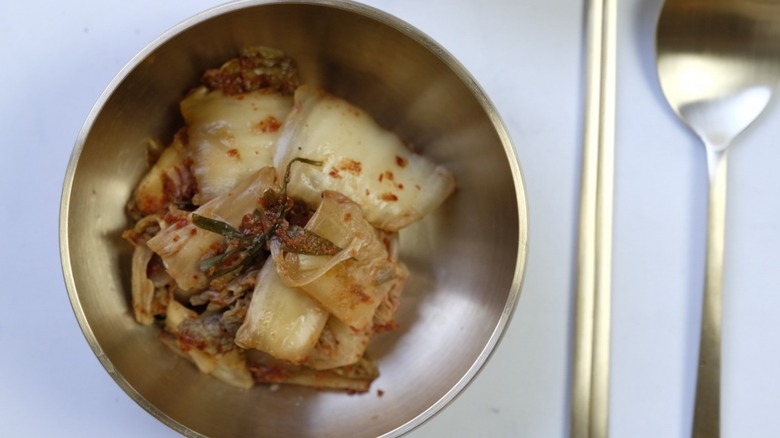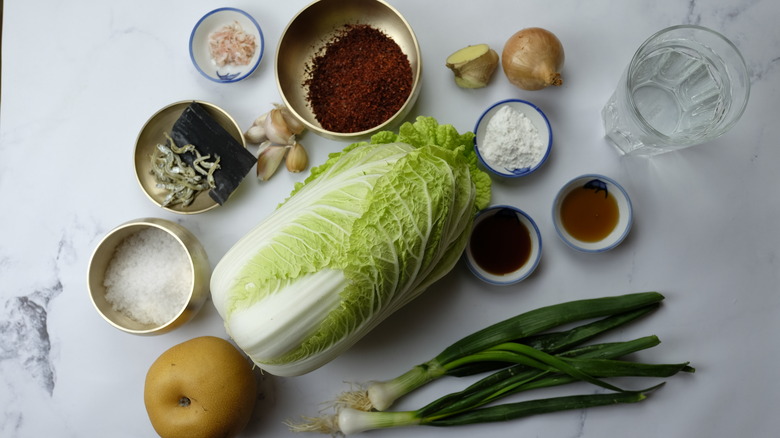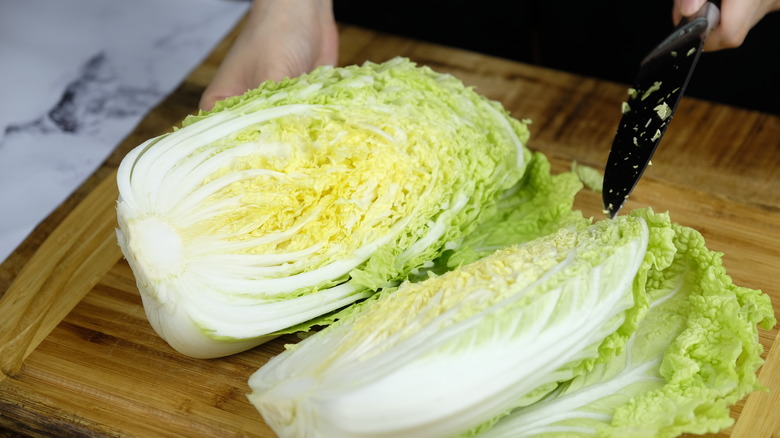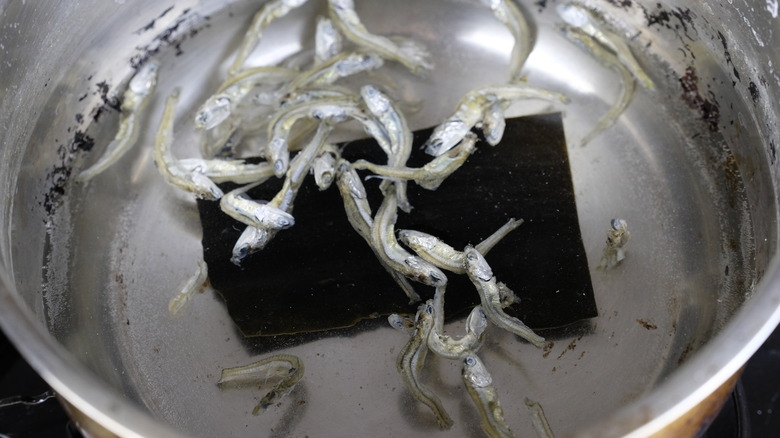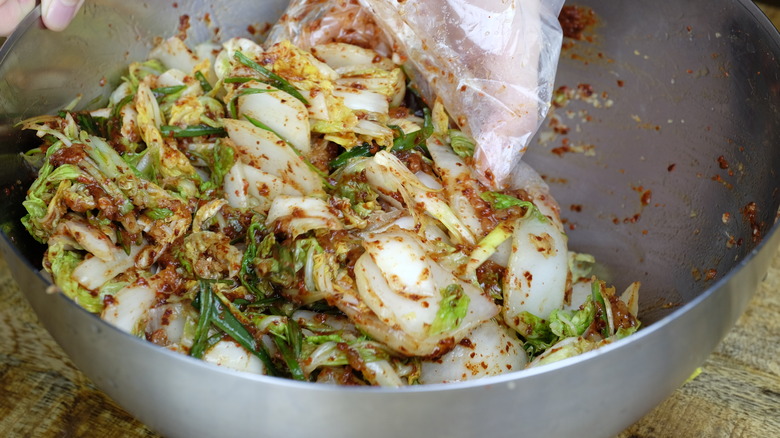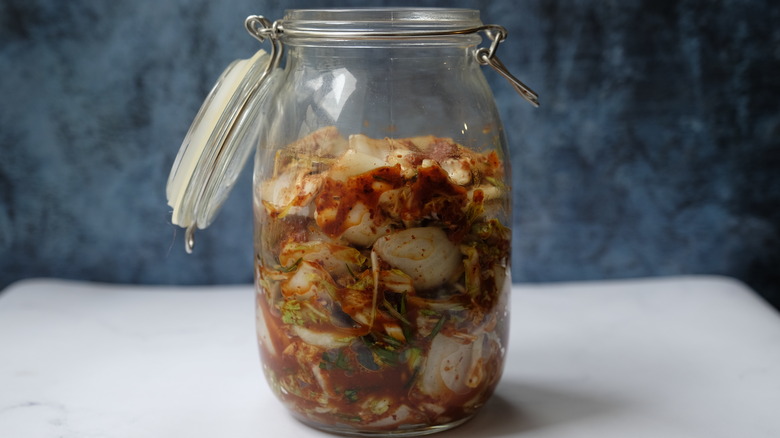Easy Homemade Kimchi Recipe
Kimchi used to be pretty much a niche food. Unless you were of Korean heritage, lived near a Korean neighborhood, or were at least tolerably familiar with Korean cuisine, you may never have tasted it. Fast forward to the 20-teens, and suddenly, fermented foods were all the rage. Cue the kimchi! Well, trends may come and trends may go, but as far as we're concerned, kimchi is more than welcome to stick around. Not only is it super-healthy, but its unique taste makes it a surprisingly versatile condiment.
Recipe developer Eric Ngo brings us this kimchi recipe that's ... well, maybe not all that easy, as easy recipes go, but is at least less complicated than most other kimchi recipes. Ngo reveals that it was his interest in fermentation that led him to develop this kimchi recipe. According to Ngo, the topic of fermentation is a fascinating one because, as he explains, "one can have the same recipe and a totally different outcome based on time and temperature. He continues, "I often say that the most delicious things in life involve fermentation: bread, croissants, cheese, wine, whisky, etc." Kimchi, of course, would also belong on that list. Ngo tells us that the recipe here is one for baechu kimchi, otherwise known as napa cabbage kimchi.
Some of the ingredients may be tricky to locate
At first glance, the list of ingredients for this kimchi may appear daunting. Ngo assures us that this is because the recipe is a really authentic one, something that would probably pass muster in any Korean kitchen. To make it, you'll need a napa cabbage weighing about two pounds, a kombu leaf, coarse salt, dried anchovies, glutinous rice flour, Korean chile flakes, scallions, part of a Korean pear, fresh ginger, a small onion, and some fish sauce.
If you can find it, you should also pick up some plum syrup, although Ngo does say it's okay to use sugar instead. He also says you could use a bosc (thought not a Bartlett) pear in place of a Korean one. You could also just use a tablespoon of sugar in place of the pear since, as he tells us, "The purpose of the pear in the recipe is to bring sweetness."
Salted shrimp are optional but add a little extra umami. Not sure where to find this stuff? Ngo says, "These ingredients are a lot more common in Korean and Japanese markets," but offers that "you could also find a good chunk of the ingredient list in Chinese markets as well." As he explains, "Korean food is very popular these days, so Asian markets are likely to have most of the ingredients available."
Start by preparing the cabbage
Slice the cabbage lengthwise into four equal pieces, then cut off the butt end of the cabbage. Ngo says you can just toss this or compost it if you're not a fan of food waste. Now take each cabbage quarter and chop it into smaller chunks, and put these chunks in a large bowl. Boil six cups of water together with the coarse salt. As Ngo reminds us, "Coarse salt is less salty than table salt," so if you're going to use the latter, only use half of this amount. Stir the water to make sure the salt dissolves. As soon as the water boils, turn off the heat and let the water cool for 10 minutes.
Once the water is somewhat cooled down, pour it over the cabbage in the bowl and mix it with a wooden spoon for 30 seconds. Let the cabbage rest for 10 minutes, then mix it again for 30 seconds, and let it rest another 10 minutes. "By this time," says Ngo, "you should be able to bend the pieces of cabbage, but they should not be cooked." After its second rest, rinse the cabbage three times in cold water, then squeeze all of the water out. Set the cabbage aside to dry for 10 minutes.
Make the sauce that will be used to thicken the kimchi
Once the cabbage is drying, it's time to make the sauce. Boil the remaining water cup and a half of water along with the kombu leaf and the dried anchovies. Once it reaches a boil, turn the heat down to low, and let the water simmer for 10 minutes. Turn the heat off and allow the kombu/anchovy-infused water to cool down and continue infusing for five minutes. Take the leaf and the anchovies out of the water and toss or compost them too.
Mix the glutinous rice flour into the cooled water, stirring for one minute. Bring the flour and water mixture to a boil over medium heat, then turn off the heat and let it cool. At this point, the mixture should thicken into a paste.
Add the rest of the ingredients to the cabbage
While the flour mixture is cooling, slice the scallions julienne-style, then grate the onion, the ginger, and the pear. If you prefer, you could puree these three ingredients together in a blender instead of grating them.
When the flour paste is cool, mix it with the Korean chile flakes, stirring until well combined. Now stir the scallions, onions, ginger, and pear into the cabbage together with the flour paste, fish sauce, and plum syrup (or sugar, if you're using that instead). If you would like to use those optional salted shrimp, stir them in as well. Mix everything together until all of the cabbage is thoroughly coated.
Allowing the kimchi to ferment a bit may improve the flavor
Store the kimchi in an airtight container. If you want the best flavor, Ngo recommends letting it sit at room temperature for a day or two. He does say that it's okay to eat the kimchi right away if you want, but explains that "when the kimchi is made fresh, it will be more sweet on the day that it is made." He goes on to say that "the longer it ferments, the more sour it will become."
This process, he tells us, is similar to the way sourdough bread is made. The rate of fermentation is determined by temperature, with a warm environment speeding things up and cold temps slowing them down. And it's not just temperature — time plays a role, too. "The younger the kimchi," says Ngo, "the sweeter the taste. The older the kimchi is, the more sour/tangy it will be." He does advise, though, that no matter how you like your kimchi, after two days, it does need to be refrigerated, and it should keep in the fridge for up to two weeks.
Easy Homemade Kimchi Recipe Directions
Trends may come and go, but kimchi is more than welcome to stick around. Not only is it healthy, but its unique taste makes it a versatile condiment.
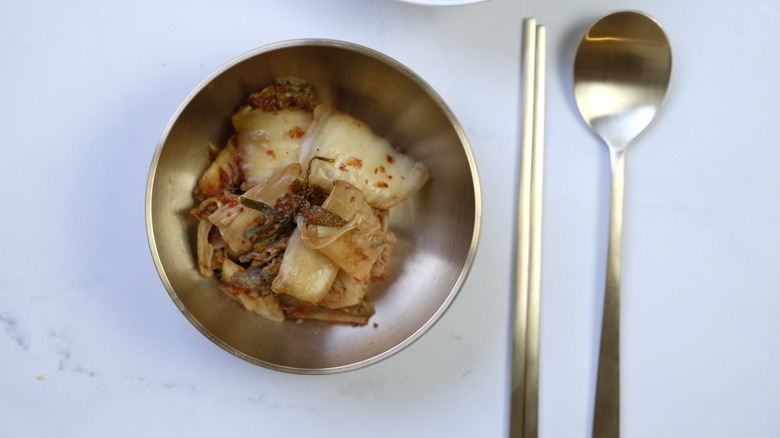
Ingredients
- 1 napa cabbage (about 2 pounds)
- 7 1/2 cups of water, divided
- 1/2 cup of coarse salt
- 1 (3-inch) piece of kombu leaf
- 5 small dried anchovies
- 1 tablespoon glutinous rice flour
- 2 scallions
- 1 small onion
- 1-inch-long piece of fresh ginger
- 1/4 Korean pear
- 1 cup Korean chile flakes
- 1 tablespoon plum syrup or sugar
- 4 tablespoons fish sauce
Optional Ingredients
- 1 tablespoon salted shrimp
Directions
- Cut the napa cabbage in quarters lengthwise, then cut off the butt end of the cabbage and dispose of it. Cut each cabbage quarter into smaller rectangles, and put them into a large bowl.
- Add 6 cups of water to a pot with the coarse salt and bring to a boil, stirring to make sure the salt is dissolved in the water. Once the water boils, turn off heat and let it cool down for 10 minutes.
- Pour the salted water over the cabbage and mix with a wooden spoon for 30 seconds.
- Let the cabbage rest for 10 minutes, mix again for 30 seconds, and let it rest for another 10 minutes.
- Rinse the cabbage 3 times in cold water and squeeze the water out. Set it aside and let it dry for 10 minutes.
- Bring the remaining 1 1/2 cups of water to a boil along with the kombu leaf and dried anchovies. Let the mixture simmer for 10 minutes on low heat, and let it cool down for 5 minutes.
- Remove the kombu leaf and anchovies from the water and discard.
- Add the glutinous rice flour to the cooled water and mix well for 1 minute.
- Bring the water/flour mixture to a boil over medium heat, then set aside to cool. The mixture should thicken into a paste.
- Julienne the scallions.
- Grate the onion, ginger, and pear, or puree them in a blender.
- Combine the cooled flour paste with the Korean chile flakes, mixing until thoroughly combined.
- Add the scallions, flour paste, and onion/ginger/pear mixture to the cabbage along with the plum syrup or sugar, the fish sauce, and the salted shrimp if you're using them. Mix until all of the cabbage is covered.
- Store the kimchi in an airtight container. For best results, let it ferment for 1 to 2 days at room temperature before refrigerating. The kimchi should keep for 2 weeks in the refrigerator.
- Serve and enjoy.
Nutrition
| Calories per Serving | 100 |
| Total Fat | 3.0 g |
| Saturated Fat | 0.6 g |
| Trans Fat | 0.0 |
| Cholesterol | 2.1 mg |
| Total Carbohydrates | 18.2 g |
| Dietary Fiber | 5.9 g |
| Total Sugars | 6.9 g |
| Sodium | 1,187.1 mg |
| Protein | 5.5 g |
